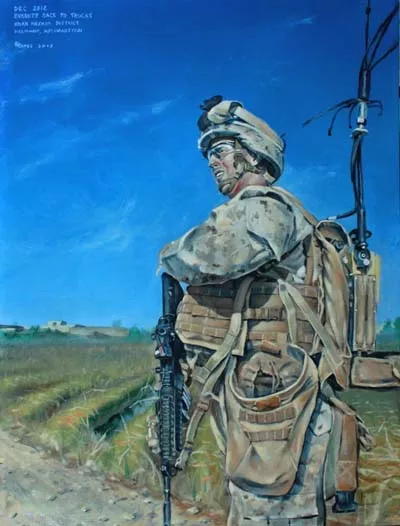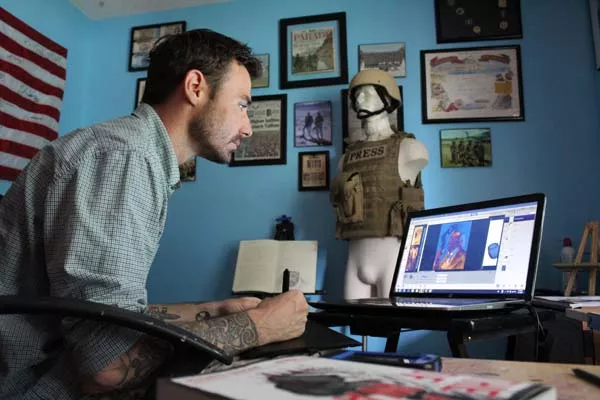Friday, May 23, 2014
Arts Combat artist Robert Bates ventures into enemy territory
Posted By Barry Falls Jr. on Fri, May 23, 2014 at 12:40 PM
Five years ago, the Taliban tried to kill Robert Bates with an improvised explosive device (IED) near the Helmand Province in Afghanistan. The now 30-year-old Marine turned to art as a means to cope with the trauma. Today, his combat art and ambition of becoming a high school art teacher are triumphant testaments to the Taliban's failure.
Bates is hosting his first solo exhibition, The Art of War, through June 5 at the Student Union Art Gallery on the UNC Charlotte campus. Bates is modest and approachable. He discusses his art without jargon or eccentric descriptions of the messages behind his pieces. He discusses his work with eagerness, pride and humor, even when he's discussing paintings of wounded soldiers. Each piece validates Bates not only as a gifted artist but as an insightful storyteller who's emotionally invested in the subjects of his craft.
Behind every work in The Art of War is a narrative of a soldier who has experienced the unimaginable. Sometimes, Bates' art centers on someone who didn't make it out of the war zone alive. He chooses to paint what he has seen on the battlefield and in hospital rooms, as it's more freeing than the stark confines of photography.
"To me, it's the shock and awe," Bates says. "I want people to have to step back and look at the marks, and pull closer and see what kind of medium I used. To me, that's really gratifying."
For "Dismount," Bates used acrylics to paint a soldier fatigued from the pounding Afghanistan heat, during his 2012 deployment to Helmand. The soldier treks through an agrarian landscape with a heavy tracker device - used to jam radio-controlled IEDs - protruding from his backpack. The explosive devices can send shock waves up to hundreds of feet away. Tens of thousands of veterans like Bates carry higher risks of developing neurological disorders and possibly future organ ailments because they were exposed to IED shock waves, according to the Institute of Medicine.

While jammers like the one in "Dismount" protect against radio-controlled IEDs, they aren't effective against pressure plate IEDs, such as the one that struck Bates' vehicle years ago. Bates recovered from his physical wounds, but the explosion left him with post-traumatic stress that is still sometimes triggered by loud, unexpected noises, like car horns.
The Art of War could mark Bates' final venture into combat art. He remains open to the idea of returning to war zones, but has no plans on doing so anytime soon; he now has a wife and son to look after.
While the shift from squad leader in the Marines to college art student and class clown at UNCC wasn't easy, his experience in Afghanistan prepared Bates for work as an illustrator in ways he never anticipated. As a Marine, he honed skills like promptness, ability to meet deadlines under pressure and an attention to detail that shows on the canvas.
Weeks before the opening night of The Art of War, Bates pulled all-nighters to keep up with deadlines and submit work to national magazines. With sweat comes reward, Bates would say. The New York Observer picked up one of his illustrations, a piece on LA Clippers owner Donald Sterling.
Bates is earning a bachelor's degree in art with a concentration in illustration. Last semester, he worked on editorial illustrations for an independent studies course under the guidance of associate art professor Jamie Franki.
Franki says there can be difficulties in instructing a student like Bates. "One challenge is adjusting my expectations of him above the expectations of a high-performance undergraduate student to that of a high-performance professional artist - to up his game in terms of what we both expect, so that we create an ambitious culture in our relationship."
And in a classroom environment where the ex-Marine sometimes appears almost peerless in his drive, he channels his ability through encouraging and motivating his classmates. According to Franki, Bates' creativity has had a ripple effect in his classroom. "If somebody comes in with a highly functioning skill set, the last thing you want to do is throw a wet blanket on it," he says. "You want to unleash that beast, because he becomes a tool in my pedagogy."
Some of Bates' work is on display in the permanent collection of the National Museum of the Marine Corps near Quantico, Virginia. Other pieces, including some showcased at The Art of War, will eventually find a home at the Smithsonian in Washington.
His previous showcase in 2012, The Joe Bonham Project, is an ongoing collective effort with other award-winning illustrators to document the recovery of American service members. Its name comes from the protagonist of the 1939 anti-war novel Johnny Got His Gun, by Dalton Trumbo. And while some might equate Bates' work to a pacifist statement, that may not be the case.
So what is the message behind The Art of War?
"That there's still a war going on over there," Bates said. "I'm taking an apolitical stand. I don't want people feeling bad for [the subjects of the art]. I don't want anyone to take a stand against them. I want to keep war in the public mind. I don't want people to forget."
Robert Bates' exhibit, The Art of War, will be on display through June 5 at UNCC's Student Union Art Gallery. An artist's reception will take place today, May 23 at 5 p.m.
Speaking of...
Comments (2)
Showing 1-2 of 2











